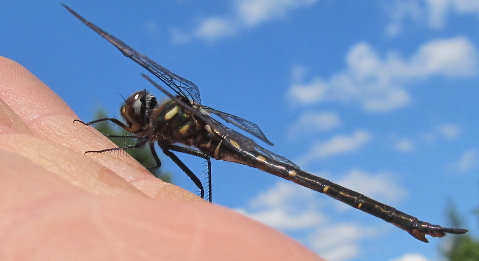A rare (for this year) sunny Monday, and another dragonfly safari in northern Lake County Minnesota. I headed back north to where I collected Somatochlora brevicincta (Quebec emerald) for the first time about 10 years ago, hoping I might have similar luck. It was a pretty unexpected place for brevicincta, a rather wide and open channel with lilypads and such, the kind of place where I’d expect to see Libellula quadrimaculata (4-spotted skimmer) and Leuchorrhinia frigida (frosted whiteface) rather than brevicincta. But today I only found the former 2 species. I know the real breeding habitat for brevicincta is the peatland to the north, but I don’t have time to trek through the woods today. I’m more curious to find out how often they use this road. I don’t find any today.
However, just across the road I saw a small dark form flying low and secretively over the narrow trickle flowing through the ditch. Somatochlora minor! The channel it was patrolling was barely a foot wide. Although one of our more common emeralds, I never tire of the green eyes, brilliant yellow spots, and the places they inhabit.

Somatochlora minor male (ocellated emerald)
Farther up the road I stopped to try and catch an Aeshna feeding over the roadbed. I haven’t seen many Aeshna yet this summer, but as summer wears on they will soon be almost everywhere. This one turns out to be the ubiquitous Aeshna canadensis (Canada darner) but several other species should appear here soon. Identifying some of the Aeshna (mosaic darners) can be tricky; if you’re still learning or want to learn to identify them the Wisconsin Dragonfly Society has a useful identification guide here.

I find some Somatocholora walshii a bit further up the road, and then head for home.I’ll come back looking for the rare A. subarctica (subarctic darner) in August or early September. By then, most of the Somatochlora will be gone.
I follow a hunch. On my way home I stop near a swampy area that has always intrigued me but I’ve never sampled. It just has “the look” of someplace that might harbor interesting species, although I can’t quite put my finger on or elucidate exactly what that look is. Its just a mix of some black ash, white cedar, and black spruce. I stop the car when I see a medium-sized dragonfly feeding back and forth over the road. It evades me several times, but as it flies overhead I see the clear silhouette of a Somatochlora-dark, slender, steady and deliberate in its flight. Rather than fly up and down the road as I often see them do, this one zigs back and forth across the road, tacking gradually east. Then it reverses course and zig-zags back and forth heading west. After several maddening cycles and about 20 minutes of this game where it always senses my interest and avoids me, it finally makes a mistake. It comes down to waist level to grab an insect, then cuts across the road into my waiting net.
My patience paid off. Its another new location for Somatochlora forcipata (forcipate emerald), the third site that I’ve found them this year including my back yard, and without too much effort. As I said last week, they are there to be found by the patient and the lucky. I’ll have to come back and investigate where the breeding habitat is.
©2017 Wayne P. Steffens
